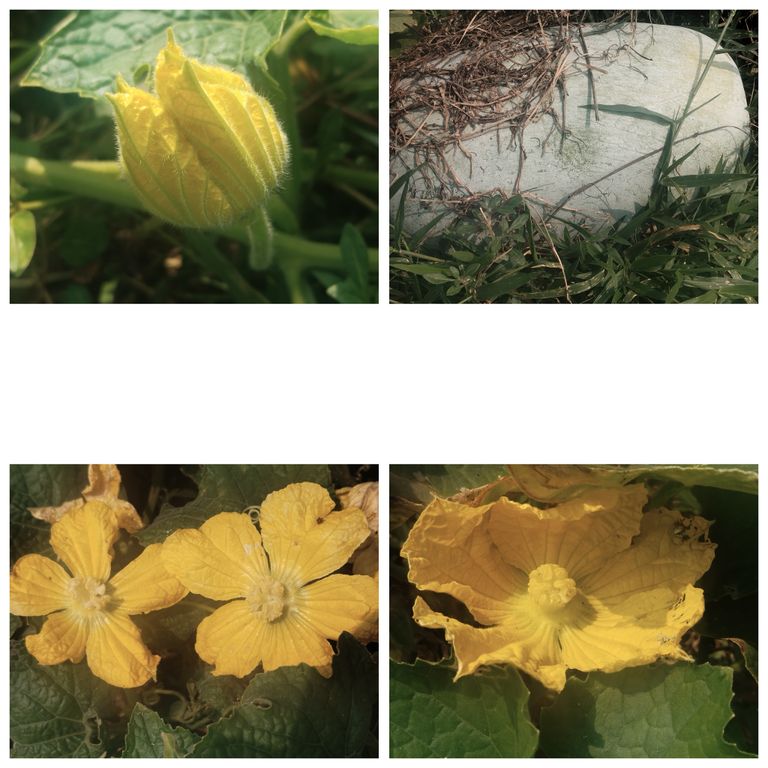
Cultivation Process of Ash Gourd Chal Kumra.
Ash gourd, also known as "chal kumra" in Bengali and "winter melon" or "white pumpkin" in English, is a popular vegetable crop grown for its nutritious fruit. It is highly adaptable, offering various health benefits due to its high fiber and water content. This article will cover all the essential steps for cultivating ash gourd, including preparation, planting, maintenance, and harvesting, to help ensure a successful crop.
- Climate and Soil Requirements
Ash gourd is best suited for warm and humid climates. It thrives in regions with temperatures between 25-35°C. While it can tolerate some variations, extremely low temperatures can hinder growth and fruiting. The plant requires ample sunlight but can manage with partial shade in very hot conditions.
Soil Requirements:
Type: Well-drained, sandy loam or loamy soil is ideal for ash gourd cultivation. Heavy clay soils can lead to water stagnation, which is detrimental to root health.
pH: A neutral to slightly acidic pH of 6.0-6.8 is suitable.
Fertility: Enrich the soil with organic matter to improve its structure and nutrient availability. Compost or well-rotted manure is highly beneficial.
- Land Preparation
Before sowing, the soil should be prepared thoroughly:
Plowing: Plow the land 2-3 times to ensure it is soft and aerated. This helps with root penetration.
Leveling and Ridges: After plowing, level the field and create ridges or raised beds to facilitate drainage, especially in areas with heavy rainfall.
Fertilizer Application: Apply 10-15 tons of farmyard manure per acre during the final plowing stage. Additionally, add a balanced dose of NPK fertilizer (Nitrogen, Phosphorus, and Potassium) as per soil test recommendations to ensure the soil is nutrient-rich.
- Seed Selection and Sowing
Seed Selection: Choose high-yielding, disease-resistant varieties of ash gourd seeds. Select seeds from reputable sources to ensure better germination rates and a healthy crop.
Seed Treatment: To prevent seed-borne diseases, soak the seeds in a fungicide solution (recommended by agricultural experts) for 15-20 minutes and then dry them before sowing.
Sowing Method:
Season: Ash gourd can be sown during spring (February-March) or monsoon (June-July) seasons.
Spacing: Space the plants about 2-3 meters apart in rows to provide ample room for vine growth.
Sowing Depth: Sow seeds about 2.5-3 cm deep in the soil. Cover them lightly with soil and water gently.
- Irrigation
Frequency: Ash gourd requires consistent moisture, especially during flowering and fruiting. However, overwatering should be avoided.
Irrigation Schedule: Water the plants every 4-5 days during the dry season. In the rainy season, monitor the moisture level and irrigate only when necessary to prevent waterlogging.
- Fertilization and Nutrient Management
Primary Fertilizer Application: For high productivity, provide balanced nutrition through fertilizers. Use nitrogen (N), phosphorus (P), and potassium (K) fertilizers in the recommended amounts based on soil testing. A general guideline is to apply:
Nitrogen (N): 60 kg/acre
Phosphorus (P): 40 kg/acre
Potassium (K): 40 kg/acre
Application Method:
At Planting: Apply one-third of nitrogen and all of the phosphorus and potassium at the time of planting.
Top Dressing: Apply the remaining nitrogen in two split doses during the growing period.
- Training and Pruning
Ash gourd vines can grow vigorously, often spreading over large areas. To ensure the best fruit quality and ease of harvesting, training and pruning are important:
Training: Provide trellises or stakes for the vines to grow on. This promotes good air circulation and sunlight exposure, reducing the risk of fungal diseases.
Pruning: Remove any weak or dead branches to redirect energy towards healthier fruiting branches.
- Pest and Disease Management
Common Pests:
Fruit Fly: Can be controlled by using traps or organic insecticides.
Aphids: Regular monitoring and applying insecticidal soap or neem oil can control aphid infestations.
Diseases:
Powdery Mildew: A common fungal infection that can be controlled with fungicidal sprays or sulfur dust.
Downy Mildew: This can be managed by ensuring good air circulation and avoiding water on the leaves. Fungicides may be applied if needed.
Preventive measures, such as crop rotation and regular field inspections, can help in managing pests and diseases effectively.
- Harvesting
Ash gourd fruits are generally ready for harvest 3-4 months after sowing. Harvesting should be done when the fruit surface appears dull and the skin is hard. Avoid harvesting immature fruits, as they won’t store well or have the best taste.
Yield: With optimal care, an acre of ash gourd can yield 8-10 tons.
Post-Harvest: After harvesting, allow the fruits to dry in a shaded, airy space for a few days to improve their storage quality. Ash gourds have a long shelf life and can be stored for several months if kept in a cool, dry place.
- Storage and Marketing
Ash gourd has excellent storage properties compared to other vegetables. After harvesting, ensure they are cleaned and dried properly before storage. They can be marketed directly or through wholesale distributors.
Conclusion
Cultivating ash gourd requires careful planning, regular maintenance, and protection against pests and diseases. By following the above practices, farmers can ensure high yields and good quality fruits, making ash gourd a profitable crop option.
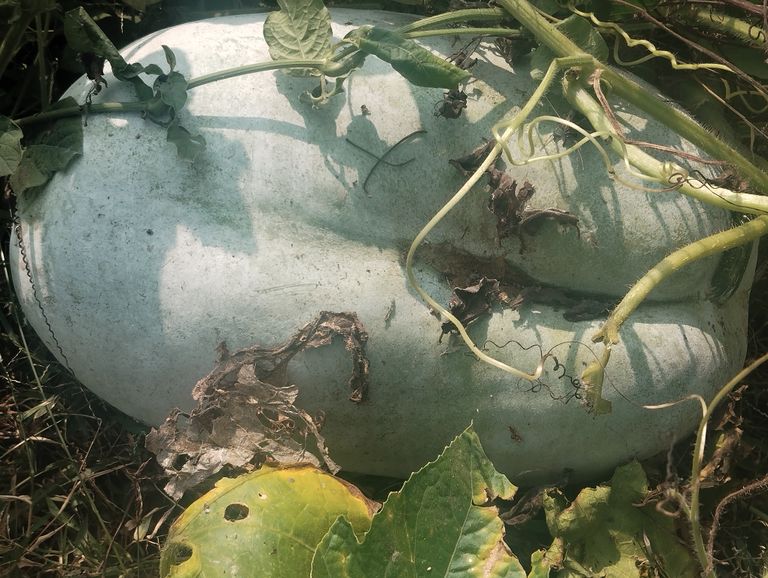
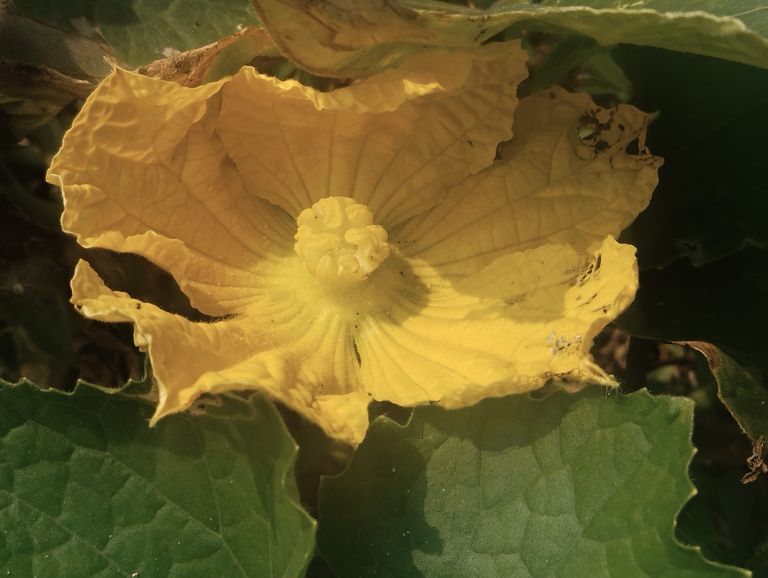
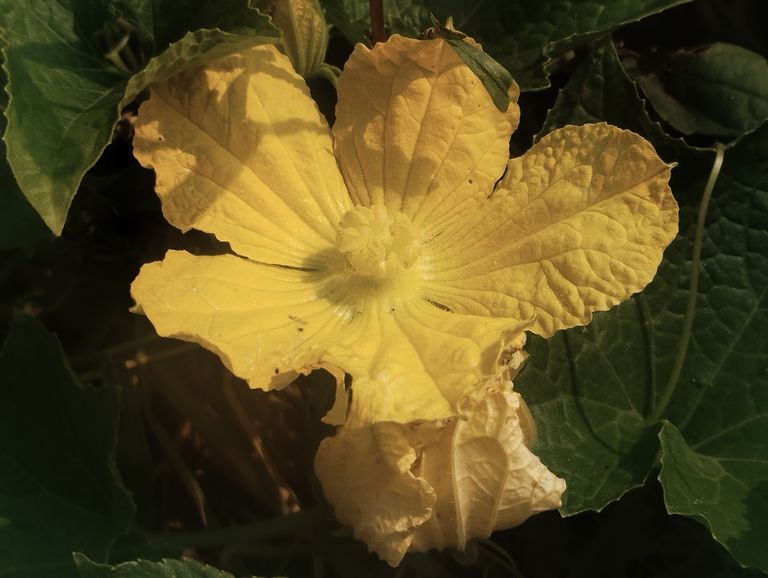
Rice Gourd Diseases and Management
The rice gourd, also known as ash gourd, is a valuable vegetable crop widely cultivated for its culinary and medicinal uses. However, like many crops, it is susceptible to various pests and diseases that can significantly impact its growth and yield. Proper identification and management of these issues are crucial for maintaining a healthy crop. This blog covers the most common diseases affecting the rice gourd, their symptoms, and practical methods to manage them effectively.
- Downy Mildew
Symptoms:
Downy mildew, caused by the fungus Pseudoperonospora cubensis, is a major disease that affects rice gourds. Infected leaves develop yellowish spots on the upper surface, which eventually turn brown. On the underside, a grayish or purple mold may appear. As the disease progresses, leaves may wither and fall, reducing the plant's photosynthesis capability and potentially stunting growth.
Management:
Use disease-free seeds and resistant varieties.
Ensure good air circulation by spacing plants appropriately.
Regularly monitor plants for early symptoms.
Apply fungicides containing metalaxyl or mancozeb, following label instructions.
- Powdery Mildew
Symptoms:
Powdery mildew, caused by fungi such as Sphaerotheca fuliginea and Erysiphe cichoracearum, appears as white powdery spots on leaves and stems. It can quickly spread across the plant, leading to leaf curl, yellowing, and premature drop. The disease thrives in warm, dry climates, making it more prominent in certain seasons.
Management:
Prune infected leaves and stems to prevent spread.
Apply sulfur-based fungicides or neem oil to control the fungal spread.
Maintain a balanced nutrient supply to strengthen plant immunity.
- Anthracnose
Symptoms:
Anthracnose is caused by Colletotrichum lagenarium and affects leaves, stems, and fruits of the rice gourd. It manifests as circular, water-soaked lesions that turn brown or black over time. These lesions can merge, creating larger dead patches that weaken the plant. The disease often spreads in warm, humid conditions.
Management:
Use disease-resistant varieties when possible.
Practice crop rotation to avoid disease buildup.
Apply fungicides like chlorothalonil or copper-based treatments.
Ensure proper drainage to reduce moisture, which encourages fungal growth.
- Fusarium Wilt
Symptoms:
Caused by the fungus Fusarium oxysporum, Fusarium wilt is a soil-borne disease that obstructs the water-conducting vessels of the plant, leading to wilting. Initially, lower leaves start to yellow and wilt, followed by the entire plant. The fungus thrives in warm soil and can survive for years, making it a persistent issue.
Management:
Rotate crops to avoid soil buildup of the pathogen.
Use resistant varieties when available.
Solarize soil by covering it with plastic during hot months to kill pathogens.
Maintain soil pH and nutrient levels for healthy growth.
- Mosaic Virus
Symptoms:
Mosaic virus, often transmitted by aphids, causes light and dark green patches on leaves. This viral infection leads to stunted growth, distorted leaves, and reduced fruit production. It is highly contagious and can spread rapidly within a field.
Management:
Control aphid populations using insecticides or natural predators.
Remove and destroy infected plants to prevent further spread.
Use virus-free seeds and resistant varieties.
Avoid handling plants excessively to reduce virus spread.
- Bacterial Wilt
Symptoms:
Bacterial wilt, caused by Ralstonia solanacearum, results in sudden wilting of the plant, often without prior yellowing of the leaves. Affected plants can collapse rapidly. When a stem is cut, a white, milky bacterial ooze may be visible.
Management:
Remove and destroy infected plants immediately.
Avoid planting in poorly-drained soils where the disease can thrive.
Rotate crops to prevent pathogen buildup in the soil.
Apply copper-based bactericides to manage bacterial spread.
- Root Rot
Symptoms:
Root rot, caused by fungi like Rhizoctonia solani, attacks the roots of the rice gourd, causing them to decay. Symptoms include yellowing, wilting, and stunted growth. Root rot is often associated with waterlogged soils and poor drainage.
Management:
Improve soil drainage to prevent waterlogging.
Avoid overwatering, especially during rainy seasons.
Treat soil with fungicides like azoxystrobin to control fungal spread.
Practice crop rotation and soil solarization to reduce pathogen levels.
- Alternaria Leaf Spot
Symptoms:
Alternaria leaf spot, caused by Alternaria cucumerina, manifests as small brown or black spots on leaves. The spots may enlarge and form concentric rings, giving the leaves a scorched appearance. This disease can cause premature leaf drop, reducing the plant’s productivity.
Management:
Remove and destroy infected plant debris.
Ensure good air circulation around plants to minimize humidity.
Apply fungicides containing chlorothalonil or mancozeb as a preventive measure.
Rotate crops to prevent recurring infections.
- Aphid Infestation (Pest Issue)
Symptoms:
Aphids are small, sap-sucking insects that weaken the plant by feeding on its nutrients. Infested plants may display yellowing, curling leaves, and stunted growth. Aphids also transmit viral diseases, compounding the problem.
Management:
Introduce natural predators like ladybugs.
Spray plants with neem oil or insecticidal soap to control aphid populations.
Remove heavily infested leaves and stems.
Avoid over-fertilizing, as it promotes lush growth that attracts aphids.
General Tips for Disease Prevention
Seed Selection: Start with disease-free, certified seeds to minimize disease introduction.
Watering Practices: Water at the base of plants to avoid wetting foliage, which encourages fungal diseases.
Sanitation: Clean up plant debris and weeds, as these can harbor diseases and pests.
Crop Rotation: Rotate crops regularly to reduce disease build-up in the soil.
Soil Health: Test soil regularly and amend as necessary to maintain pH and nutrient levels, which support plant immunity.
By implementing these disease management practices, farmers can ensure a healthy rice gourd crop and maximize yield. Early detection, preventive care, and regular monitoring are key to successfully managing the challenges posed by pests and diseases in rice gourd cultivation.

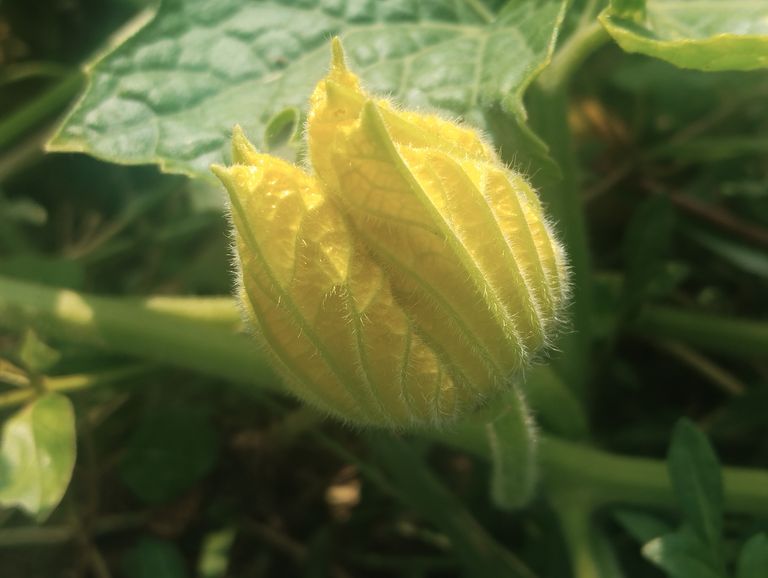
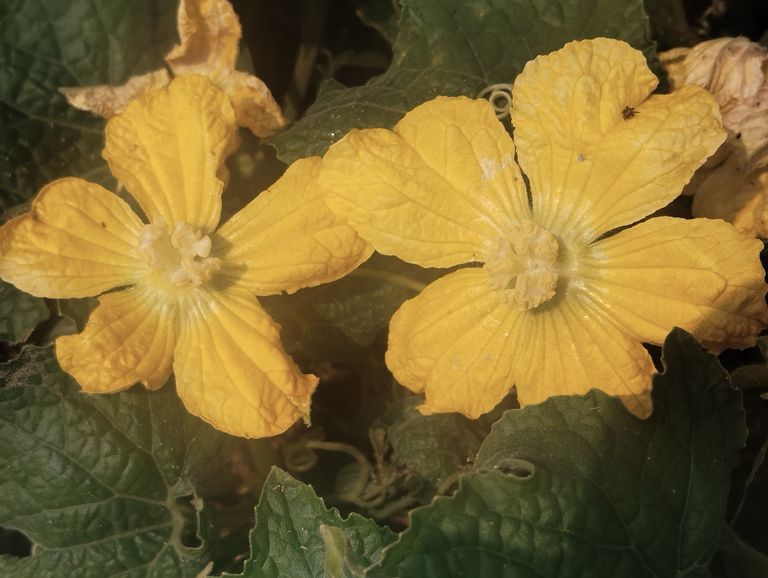
Here’s a detailed recipe blog in English for Chal Kumro Jaan (Pumpkin in Bengali-style with Rice):
Chal Kumro Jaan Recipe – Bengali Pumpkin Rice Delight
Total Time: 45 minutes
Servings: 4
Pumpkin, or "chal kumro" in Bengali, is celebrated in traditional Bengali cuisine. This delicious rice-based recipe blends the sweetness of pumpkin with aromatic spices, creating a rich and nutritious dish perfect for any meal.
Ingredients
Basmati rice – 1 cup, washed and soaked
Pumpkin – 250 grams, peeled and diced
Mustard oil – 2 tablespoons
Bay leaf – 1
Cumin seeds – 1/2 teaspoon
Green chili – 2, slit
Ginger – 1-inch piece, finely chopped
Turmeric powder – 1/2 teaspoon
Red chili powder – 1/4 teaspoon (optional)
Garam masala powder – 1/4 teaspoon
Salt – to taste
Water – 2 cups
Fresh coriander leaves – for garnish
Instructions
Step 1: Preparing the Ingredients
- Pumpkin Preparation: Start by peeling and chopping the pumpkin into small cubes. Ensure they’re of uniform size so they cook evenly.
- Rice Preparation: Wash the basmati rice thoroughly and let it soak for about 20 minutes. This will make it fluffier and reduce cooking time.
Step 2: Cooking the Pumpkin
- Heat Mustard Oil: In a large, heavy-bottomed pan, heat 2 tablespoons of mustard oil. Once hot, add the bay leaf and cumin seeds.
- Add Aromatics: Add the green chilies and chopped ginger, stirring until the ginger turns golden brown.
- Cook the Pumpkin: Add the diced pumpkin to the pan, stirring to coat it well in the oil and spices. Sprinkle in the turmeric and red chili powder, and season with salt. Stir well, then cover and cook for 5-7 minutes on low heat, stirring occasionally until the pumpkin begins to soften.
Step 3: Adding the Rice
- Add Rice to Pumpkin: Once the pumpkin is tender, drain the soaked rice and add it to the pan. Stir gently to coat the rice with the spices and pumpkin.
- Add Water: Pour in 2 cups of water, stir, and bring the mixture to a gentle boil. Adjust salt as needed.
- Simmer: Cover the pan with a lid, reduce the heat to low, and let it simmer for 15-20 minutes until the rice is fully cooked, and the water is absorbed.
Step 4: Garnish and Serve
- Fluff and Garnish: Once the rice is cooked, gently fluff it with a fork. Add a sprinkle of garam masala powder and garnish with fresh coriander leaves.
- Serve Hot: Chal Kumro Jaan is best enjoyed warm, accompanied by a side of yogurt or a light salad.
Tips and Variations
Additional Veggies: Add green peas or diced carrots for extra color and nutrition.
Fried Onions: Garnish with crispy fried onions for a crunchier texture and added flavor.
Spice Level: Adjust the green and red chilies according to your spice preference.
Nutritional Benefits
Pumpkin is rich in beta-carotene, fiber, and essential vitamins, making this dish both hearty and nutritious. Pairing pumpkin with rice balances the meal with essential carbs, while mustard oil adds beneficial fats and a distinct Bengali flavor.
Enjoy this comforting Chal Kumro Jaan with your family and bring a taste of Bengal to your dining table!

Here’s a detailed recipe blog in English for Chal Kumro Jaan (Pumpkin in Bengali-style with Rice):
Chal Kumro Jaan Recipe – Bengali Pumpkin Rice Delight
Total Time: 45 minutes
Servings: 4
Pumpkin, or "chal kumro" in Bengali, is celebrated in traditional Bengali cuisine. This delicious rice-based recipe blends the sweetness of pumpkin with aromatic spices, creating a rich and nutritious dish perfect for any meal.
Ingredients
Basmati rice – 1 cup, washed and soaked
Pumpkin – 250 grams, peeled and diced
Mustard oil – 2 tablespoons
Bay leaf – 1
Cumin seeds – 1/2 teaspoon
Green chili – 2, slit
Ginger – 1-inch piece, finely chopped
Turmeric powder – 1/2 teaspoon
Red chili powder – 1/4 teaspoon (optional)
Garam masala powder – 1/4 teaspoon
Salt – to taste
Water – 2 cups
Fresh coriander leaves – for garnish
Instructions
Step 1: Preparing the Ingredients
- Pumpkin Preparation: Start by peeling and chopping the pumpkin into small cubes. Ensure they’re of uniform size so they cook evenly.
- Rice Preparation: Wash the basmati rice thoroughly and let it soak for about 20 minutes. This will make it fluffier and reduce cooking time.
Step 2: Cooking the Pumpkin
- Heat Mustard Oil: In a large, heavy-bottomed pan, heat 2 tablespoons of mustard oil. Once hot, add the bay leaf and cumin seeds.
- Add Aromatics: Add the green chilies and chopped ginger, stirring until the ginger turns golden brown.
- Cook the Pumpkin: Add the diced pumpkin to the pan, stirring to coat it well in the oil and spices. Sprinkle in the turmeric and red chili powder, and season with salt. Stir well, then cover and cook for 5-7 minutes on low heat, stirring occasionally until the pumpkin begins to soften.
Step 3: Adding the Rice
- Add Rice to Pumpkin: Once the pumpkin is tender, drain the soaked rice and add it to the pan. Stir gently to coat the rice with the spices and pumpkin.
- Add Water: Pour in 2 cups of water, stir, and bring the mixture to a gentle boil. Adjust salt as needed.
- Simmer: Cover the pan with a lid, reduce the heat to low, and let it simmer for 15-20 minutes until the rice is fully cooked, and the water is absorbed.
Step 4: Garnish and Serve
- Fluff and Garnish: Once the rice is cooked, gently fluff it with a fork. Add a sprinkle of garam masala powder and garnish with fresh coriander leaves.
- Serve Hot: Chal Kumro Jaan is best enjoyed warm, accompanied by a side of yogurt or a light salad.
Tips and Variations
Additional Veggies: Add green peas or diced carrots for extra color and nutrition.
Fried Onions: Garnish with crispy fried onions for a crunchier texture and added flavor.
Spice Level: Adjust the green and red chilies according to your spice preference.
Nutritional Benefits
Pumpkin is rich in beta-carotene, fiber, and essential vitamins, making this dish both hearty and nutritious. Pairing pumpkin with rice balances the meal with essential carbs, while mustard oil adds beneficial fats and a distinct Bengali flavor.